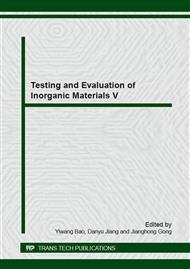p.406
p.410
p.418
p.422
p.427
p.431
p.439
p.443
p.447
Fracture Features of Mullite Ceramic Regenerative Material under Thermal Shock Condition
Abstract:
For study the damage characteristic of the mullite heat storage ceramic under thermal shock condition, mechanical properties of mullite have been investigated. Under the different cooling mediums (room temperature water, boiling water, air), single and five cycles thermal shock conditions, The article studied the variation of flexural strength and fracture toughness along with temperature. The result show that with the increase of heat transfer coefficient of cooling medium, the bending strength of ceramic decreased. In the 600°C,the ceramic have a maximum bending strength and a minimum fracture toughness. The fracture toughness of precrack specimen is lower than that of non-precrack specimen on the whole. Both Precrack ceramic and non-precrack ceramic have a maximum fracture toughness at 400°C. The study of this paper provides a theoretical basis for the better predicting fracture damage and service life of heat storage ceramic.
Info:
Periodical:
Pages:
427-430
Citation:
Online since:
November 2014
Authors:
Keywords:
Price:
Сopyright:
© 2015 Trans Tech Publications Ltd. All Rights Reserved
Share:
Citation:


